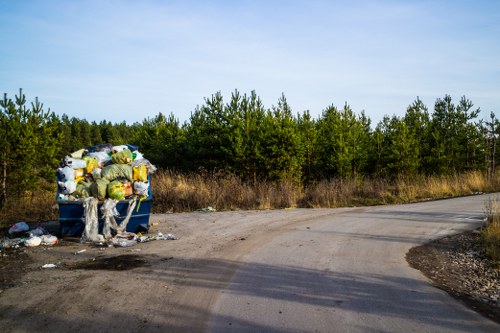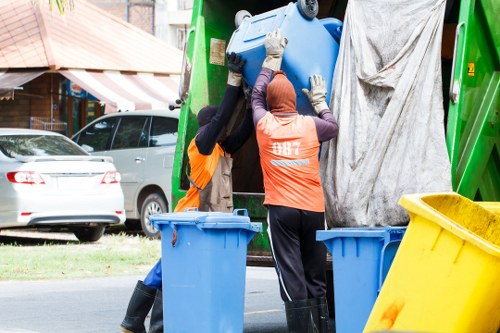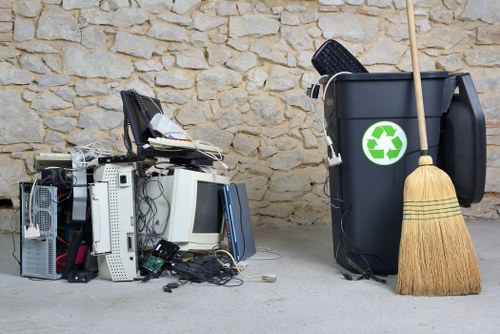Loft Clearance in Commercial Waste Collection

Loft clearance plays a crucial role in the realm of commercial waste collection. As businesses grow and evolve, the accumulation of unwanted materials in attics or storage spaces can become a significant hurdle. Efficiently managing and clearing loft spaces not only enhances the functionality of a commercial property but also contributes to environmental sustainability.
Commercial properties, such as offices, retail stores, and industrial facilities, often have limited space. Over time, items like old furniture, packaging materials, and outdated equipment can clutter loft areas, making them inefficient and sometimes even a safety hazard. Addressing loft clearance promptly ensures that businesses can maintain a clean and organized workspace.
Effective loft clearance requires a systematic approach. It involves assessing the items to be removed, categorizing waste, and ensuring that all materials are disposed of in compliance with local regulations. This not only helps in maintaining cleanliness but also in promoting recycling and responsible waste management practices.

The Importance of Loft Clearance in Commercial Settings
Maintaining a clutter-free loft is essential for several reasons. Firstly, it optimizes the use of space, allowing businesses to utilize their premises more efficiently. A well-organized loft can serve multiple purposes, such as additional storage, workspace, or even as an emergency exit route.
Secondly, loft clearance contributes to the overall safety of the workplace. Accumulated waste can pose fire hazards, obstruct emergency exits, and create an environment conducive to accidents. By regularly clearing loft spaces, businesses can mitigate these risks and ensure a safer environment for employees and visitors.
Moreover, effective loft clearance aligns with corporate social responsibility initiatives. Businesses increasingly recognize the importance of sustainable practices, and responsible waste management is a key component. By partnering with commercial waste collection services that prioritize eco-friendly disposal methods, companies can reduce their environmental footprint.

Steps to an Efficient Loft Clearance Process
Implementing an efficient loft clearance process involves several key steps:
- Assessment: Begin by evaluating the contents of the loft. Identify items that are no longer needed and categorize them based on their material type and disposal requirements.
- Planning: Develop a clearance plan that outlines the sequence of removal, the necessary equipment, and the personnel involved. Ensure that the plan complies with safety regulations.
- Segregation: Separate recyclable materials from non-recyclable waste. This facilitates easier processing and ensures that recyclable items are handled appropriately.
- Disposal: Partner with a reputable commercial waste collection service that adheres to environmental standards. Ensure that all waste is disposed of legally and responsibly.
- Documentation: Keep records of the clearance process, including the types and quantities of waste removed. This is essential for compliance and for tracking sustainability efforts.
By following these steps, businesses can ensure a smooth and effective loft clearance, minimizing disruptions and maximizing efficiency.

Choosing the Right Commercial Waste Collection Service
Selecting a reliable commercial waste collection service is paramount for successful loft clearance. Here are factors to consider when making this choice:
- Experience and Expertise: Opt for companies with a proven track record in handling commercial waste. Experienced providers are better equipped to manage diverse waste types and navigate the complexities of large-scale clearances.
- Compliance and Certifications: Ensure that the service provider complies with local waste management regulations and holds necessary certifications. This guarantees that waste is handled and disposed of legally and responsibly.
- Recycling Capabilities: A service that prioritizes recycling and sustainability can help your business reduce its environmental impact. Inquire about their recycling processes and the types of materials they can recycle.
- Customer Service: Responsive and professional customer service is essential for addressing any concerns and ensuring a smooth clearance process. Look for providers that offer support and clear communication.
- Cost-Effectiveness: While cost should not be the sole deciding factor, it is important to choose a service that offers competitive pricing without compromising on quality.
By carefully evaluating these factors, businesses can select a commercial waste collection service that meets their specific needs and supports their sustainability goals.

Benefits of Professional Loft Clearance Services
Engaging professional loft clearance services offers numerous advantages:
- Time Efficiency: Professionals can complete loft clearance swiftly, minimizing downtime and allowing businesses to focus on their core operations.
- Expert Handling: Trained personnel ensure that all items are handled safely and efficiently, reducing the risk of damage or injury.
- Comprehensive Services: Professional services often provide end-to-end solutions, including assessment, removal, recycling, and disposal, ensuring a seamless clearance process.
- Cost Savings: While there is an upfront cost, professional clearance can save money in the long run by preventing potential fines for improper waste disposal and by optimizing space utilization.
- Environmental Responsibility: Professionals ensure that waste is managed in an eco-friendly manner, supporting businesses in their sustainability initiatives.
Leveraging the expertise of professional loft clearance services can lead to a more organized, safe, and sustainable commercial environment.

Environmental Impact of Loft Clearance
The environmental implications of loft clearance are significant. Improper disposal of waste can lead to pollution, resource depletion, and increased greenhouse gas emissions. However, responsible loft clearance practices can mitigate these impacts.
Recycling and repurposing items during the clearance process helps conserve natural resources and reduces the need for raw material extraction. It also minimizes the amount of waste sent to landfills, which are major sources of methane, a potent greenhouse gas.
Additionally, by partnering with eco-conscious waste collection services, businesses contribute to broader environmental goals. These services often employ sustainable practices, such as waste sorting, energy-efficient transportation, and adherence to environmental regulations, further reducing the ecological footprint of loft clearance activities.

Regulatory Considerations in Commercial Loft Clearance
Compliance with local and national regulations is essential in commercial loft clearance. These regulations govern how different types of waste must be handled, stored, and disposed of to protect public health and the environment.
Businesses must be aware of the specific waste categories they generate, such as hazardous materials, electronic waste, or general refuse, and ensure that each is managed according to legal requirements. Failure to comply can result in hefty fines, legal action, and damage to the company's reputation.
To navigate these regulations effectively, collaborating with knowledgeable waste collection services is beneficial. These providers stay updated on changing laws and can offer guidance on compliant waste management practices, ensuring that businesses avoid legal pitfalls and maintain their operational integrity.

Cost Analysis of Loft Clearance in Commercial Waste Collection
Understanding the cost dynamics of loft clearance is vital for budgeting and financial planning in any business. Several factors influence the overall cost, including the volume and type of waste, the complexity of the clearance process, and the proximity of the commercial waste collection service.
Businesses should consider both direct and indirect costs. Direct costs encompass the fees charged by waste collection services, disposal fees, and any additional charges for handling specialized waste. Indirect costs might include lost productivity during the clearance process, potential disruptions to operations, and the costs associated with non-compliance.
Conducting a thorough cost-benefit analysis can help businesses determine the most economical and efficient approach to loft clearance. Investing in professional services might seem costly initially but can lead to long-term savings by optimizing waste management practices, reducing environmental risks, and improving operational efficiency.

Innovations in Commercial Waste Collection for Loft Clearance
The commercial waste collection industry is continually evolving, with innovations aimed at enhancing efficiency and sustainability. Technological advancements play a significant role in transforming loft clearance services.
One such innovation is the use of digital platforms for waste tracking and management. These platforms enable businesses to monitor their waste generation, track disposal processes, and generate reports for compliance and sustainability metrics.
Moreover, advancements in recycling technologies have expanded the range of materials that can be effectively recycled, reducing the reliance on landfills. Automation and machinery designed for waste sorting and handling have also increased the speed and precision of the clearance process, minimizing human error and enhancing overall efficiency.

Best Practices for Sustainable Loft Clearance
Adopting sustainable practices in loft clearance ensures that waste management aligns with environmental stewardship goals. Here are some best practices for businesses:
- Reduce: Minimize waste generation by implementing efficient storage solutions and regularly evaluating the necessity of stored items.
- Reuse: Identify items that can be repurposed or donated to extend their lifecycle and prevent unnecessary disposal.
- Recycle: Ensure that recyclable materials are properly sorted and processed, contributing to resource conservation.
- Educate: Train employees on sustainable waste management practices to foster a culture of environmental responsibility.
- Partner: Collaborate with waste collection services that prioritize sustainability and have robust recycling programs.
Implementing these practices not only benefits the environment but can also enhance the company’s reputation and compliance with regulatory standards.

Case Studies: Successful Loft Clearance in Commercial Settings
Examining real-world examples of successful loft clearance provides valuable insights into effective waste management strategies. One notable case involves a large corporate office that faced significant challenges with accumulated waste in its loft. By partnering with a specialized commercial waste collection service, they implemented a comprehensive clearance plan that included waste segregation, recycling, and proper disposal, resulting in a more organized and sustainable workspace.
Another example is a retail store that needed to clear its loft to create additional storage space for inventory. The waste collection service efficiently handled the removal of old stock, packaging materials, and obsolete equipment, enhancing the store's operational efficiency and reducing its environmental impact.
These case studies highlight the importance of strategic planning, professional expertise, and sustainable practices in achieving successful loft clearance outcomes.

Future Trends in Commercial Waste Collection and Loft Clearance
The future of commercial waste collection and loft clearance is poised for significant advancements. Emerging trends focus on enhancing sustainability, leveraging technology, and improving operational efficiency.
One key trend is the increasing adoption of circular economy principles, where waste is minimized, and materials are continuously reused and recycled. This approach not only reduces environmental impact but also fosters innovation in waste management practices.
Additionally, the integration of smart technologies, such as IoT devices and data analytics, is revolutionizing waste collection. These technologies enable real-time monitoring of waste levels, predictive maintenance of equipment, and optimized routing for waste collection vehicles, enhancing overall efficiency and reducing operational costs.

Implementing a Sustainable Loft Clearance Strategy
Developing a sustainable strategy for loft clearance involves a combination of planning, collaboration, and continuous improvement. Businesses should start by setting clear objectives for their waste management goals, aligning them with broader sustainability initiatives.
Collaboration with waste collection services that emphasize sustainability is crucial. These partners can provide the expertise and resources needed to implement effective waste segregation, recycling, and disposal practices.
Continuous improvement is also essential. Regularly reviewing and assessing the loft clearance process allows businesses to identify areas for enhancement, adopt new technologies, and stay abreast of evolving regulations and best practices.

Conclusion: The Integral Role of Loft Clearance in Commercial Waste Management
Loft clearance is a vital component of commercial waste collection, contributing to operational efficiency, environmental sustainability, and regulatory compliance. By adopting systematic clearance processes, partnering with reliable waste collection services, and embracing sustainable practices, businesses can effectively manage their waste, optimize their spaces, and uphold their commitment to environmental stewardship.
As the commercial landscape continues to evolve, the importance of efficient and sustainable loft clearance will only grow. Investing in robust waste management strategies ensures that businesses remain competitive, responsible, and prepared to meet future challenges.
Ready to optimize your commercial space and enhance your waste management practices? Contact us today to book your loft clearance service and take a step towards a cleaner, more sustainable future.